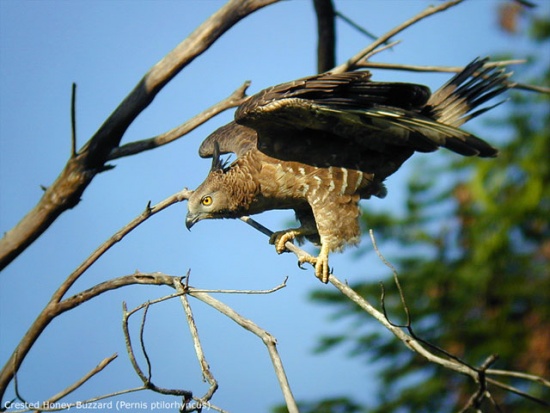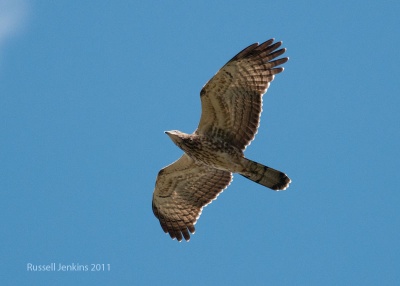(alt tax) |
(range, taxon, refs) |
||
| Line 12: | Line 12: | ||
Not easy to distinguish from [[European Honey Buzzard]], which overlap in the [[Middle East]]<sup>[[#References|[1]]]</sup>. | Not easy to distinguish from [[European Honey Buzzard]], which overlap in the [[Middle East]]<sup>[[#References|[1]]]</sup>. | ||
==Distribution== | ==Distribution== | ||
| − | [[Siberia]] east to [[Japan]] and south to [[Indonesia]] and The [[Philippines]]. Northern populations are migratory | + | [[Siberia]] east to [[Japan]] and south to [[India]], [[Sri Lanka]], [[Indonesia]] and The [[Philippines]]. Northern populations are migratory |
==Taxonomy== | ==Taxonomy== | ||
| − | Considered conspecific with [[European Honey Buzzard]] by some authors. | + | Considered [[Dictionary_A-C#C|conspecific]] with [[European Honey Buzzard]] by some authors. |
| − | Reference [[#References|[ | + | Reference [[#References|[5]]] notes that differences in DNA and morphology support a split into 2 species: "Oriental Honeybuzzard" (strict sense), ''P. orientalis'', with subspecies ''orientalis'', ''philippensis'' and ''ruficollis''; and "Sunda Honeybuzzard", ''P. ptilorhynchus'' with ''palawanensis'', ''ptilorhynchus'' and ''torquatus''. Some sources think this should be three species. |
====Subspecies==== | ====Subspecies==== | ||
Clements recognises the following subspecies [[#References|[1]]]: | Clements recognises the following subspecies [[#References|[1]]]: | ||
| − | *''P. p. orientalis'': "''' | + | *''P. p. orientalis'': "'''Northern Honeybuzzard'''". South [[Siberia]] to [[Mongolia]] and [[Japan]]; winters to [[Greater Sundas]] |
| − | *''P. p. ruficollis'': "''' | + | *''P. p. ruficollis'': "'''Indomalayan Honeybuzzard'''". [[India]] and [[Sri Lanka]] to south west [[China]], [[Myanmar]] and south-east [[Asia]] except the Malaysia Peninsula. |
| − | *''P. p. philippensis'': "''' | + | *''P. p. philippensis'': "'''Indomalayan Honeybuzzard'''". North and east [[Philippines]] |
| − | *''P. p. palawanensis'': "'''Sunda Honeybuzzard'''". South Philippines (Palawan and Calauit) | + | *''P. p. palawanensis'': "'''Sunda Honeybuzzard'''". South [[Philippines]] (Palawan and Calauit) |
| − | *''P. p. torquatus'': "'''Sunda Honeybuzzard'''". Malay Peninsula, Sumatra and Borneo | + | *''P. p. torquatus'': "'''Sunda Honeybuzzard'''". [[Malay Peninsula]], [[Sumatra]] and [[Borneo]] |
| − | *''P. p. ptilorhynchus'': "'''Sunda Honeybuzzard'''" Java | + | *''P. p. ptilorhynchus'': "'''Sunda Honeybuzzard'''" [[Java]] |
==Habitat== | ==Habitat== | ||
[[Image:Oriental_Honey_Buzzard_by_stoop.jpg|thumb|400px|right|Subspecies ''P. p. orientalis'' : Migrating female <br />Photo © by {{user|stoop|stoop}}<br />Yamamoto Mountain, Ojiya, Niigata, [[Japan]], September 2011]] | [[Image:Oriental_Honey_Buzzard_by_stoop.jpg|thumb|400px|right|Subspecies ''P. p. orientalis'' : Migrating female <br />Photo © by {{user|stoop|stoop}}<br />Yamamoto Mountain, Ojiya, Niigata, [[Japan]], September 2011]] | ||
| Line 32: | Line 32: | ||
It is a specialist feeder, living mainly on the larvae and nests of wasps, although it will take other small prey. | It is a specialist feeder, living mainly on the larvae and nests of wasps, although it will take other small prey. | ||
==References== | ==References== | ||
| − | #{{Ref- | + | #{{Ref-Clements6thOct23}}#{{Ref-GillDonskerRasmussen22V13.2}}#Handbook of the Birds of the World Alive (retrieved Jan 2018) |
#[http://www.birdforum.net/showthread.php?t=53882 Birdforum thread] discussing separating this species from Eurasian Honey Buzzard | #[http://www.birdforum.net/showthread.php?t=53882 Birdforum thread] discussing separating this species from Eurasian Honey Buzzard | ||
#{{Ref-Eatonetal21}} | #{{Ref-Eatonetal21}} | ||
Latest revision as of 23:57, 16 April 2024
Alternative name: Crested Honey Buzzard
Includes: Sunda Honeybuzzard
- Pernis ptilorhynchus
Identification
52–68 cm (20½-26¾ in)
The male has a blue-grey head, while the female's head is brown. She is slightly larger and darker than the male. The male has a black tail with a white band, whilst the female resembles female European Honey Buzzard.
Similar Species
Not easy to distinguish from European Honey Buzzard, which overlap in the Middle East[1].
Distribution
Siberia east to Japan and south to India, Sri Lanka, Indonesia and The Philippines. Northern populations are migratory
Taxonomy
Considered conspecific with European Honey Buzzard by some authors.
Reference [5] notes that differences in DNA and morphology support a split into 2 species: "Oriental Honeybuzzard" (strict sense), P. orientalis, with subspecies orientalis, philippensis and ruficollis; and "Sunda Honeybuzzard", P. ptilorhynchus with palawanensis, ptilorhynchus and torquatus. Some sources think this should be three species.
Subspecies
Clements recognises the following subspecies [1]:
- P. p. orientalis: "Northern Honeybuzzard". South Siberia to Mongolia and Japan; winters to Greater Sundas
- P. p. ruficollis: "Indomalayan Honeybuzzard". India and Sri Lanka to south west China, Myanmar and south-east Asia except the Malaysia Peninsula.
- P. p. philippensis: "Indomalayan Honeybuzzard". North and east Philippines
- P. p. palawanensis: "Sunda Honeybuzzard". South Philippines (Palawan and Calauit)
- P. p. torquatus: "Sunda Honeybuzzard". Malay Peninsula, Sumatra and Borneo
- P. p. ptilorhynchus: "Sunda Honeybuzzard" Java
Habitat
A variety of woodland, with a preference for broadleafed trees.
Behaviour
Diet
It is a specialist feeder, living mainly on the larvae and nests of wasps, although it will take other small prey.
References
- Clements, J. F., P. C. Rasmussen, T. S. Schulenberg, M. J. Iliff, T. A. Fredericks, J. A. Gerbracht, D. Lepage, A. Spencer, S. M. Billerman, B. L. Sullivan, and C. L. Wood. 2023. The eBird/Clements checklist of Birds of the World: v2023. Downloaded from https://www.birds.cornell.edu/clementschecklist/download/
- Gill, F, D Donsker, and P Rasmussen (Eds). 2023. IOC World Bird List (v 13.2). Doi 10.14344/IOC.ML.13.2. http://www.worldbirdnames.org/
- Handbook of the Birds of the World Alive (retrieved Jan 2018)
- Birdforum thread discussing separating this species from Eurasian Honey Buzzard
- Eaton, JA, B van Balen, NW Brickle, FE Rheindt 2021. Birds of the Indonesian Archipelago (Greater Sundas and Wallacea), Second Edition. Lynx Editions. ISBN978-84-16728-44-2
External Links
GSearch checked for 2020 platform.1






